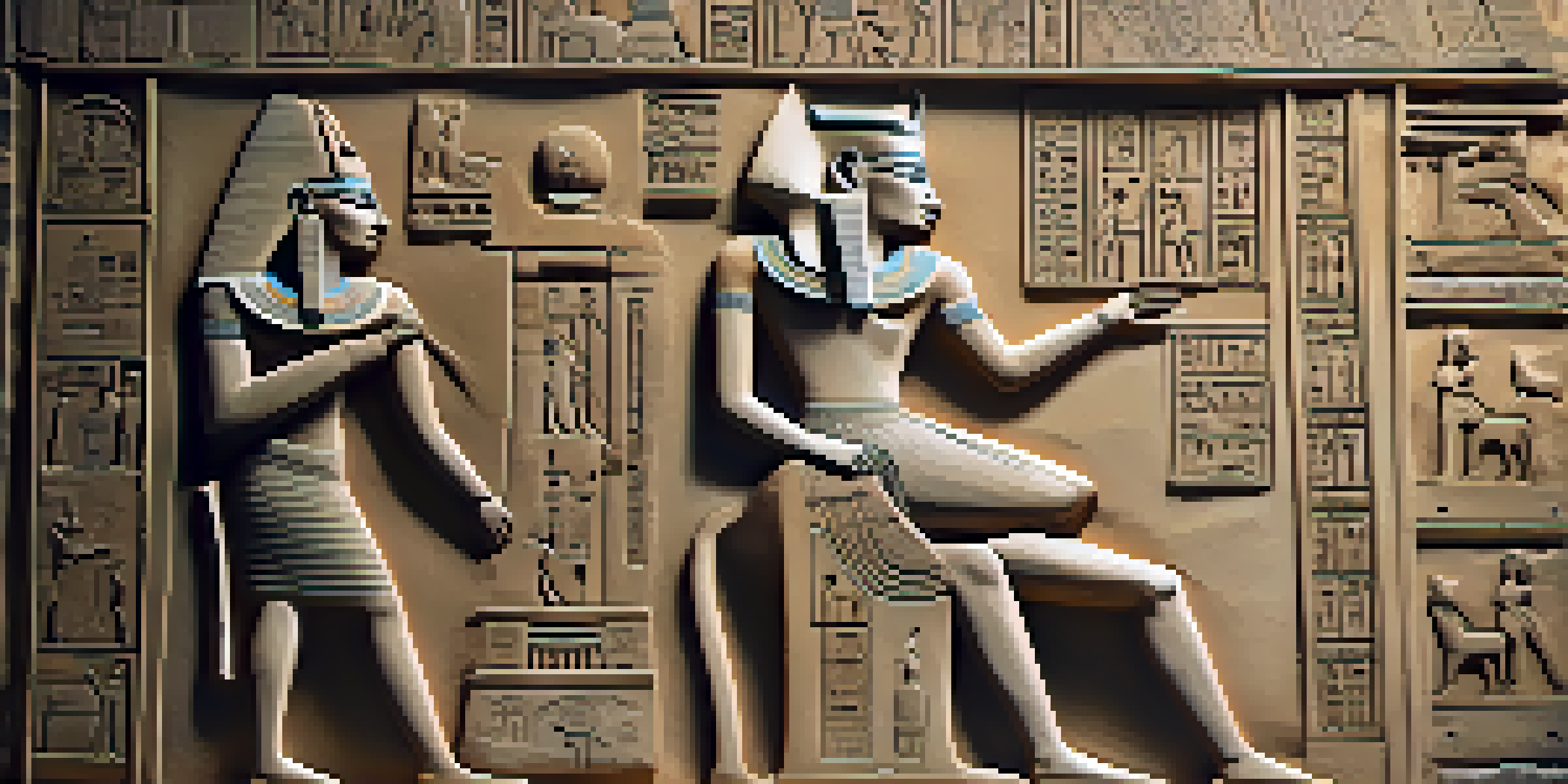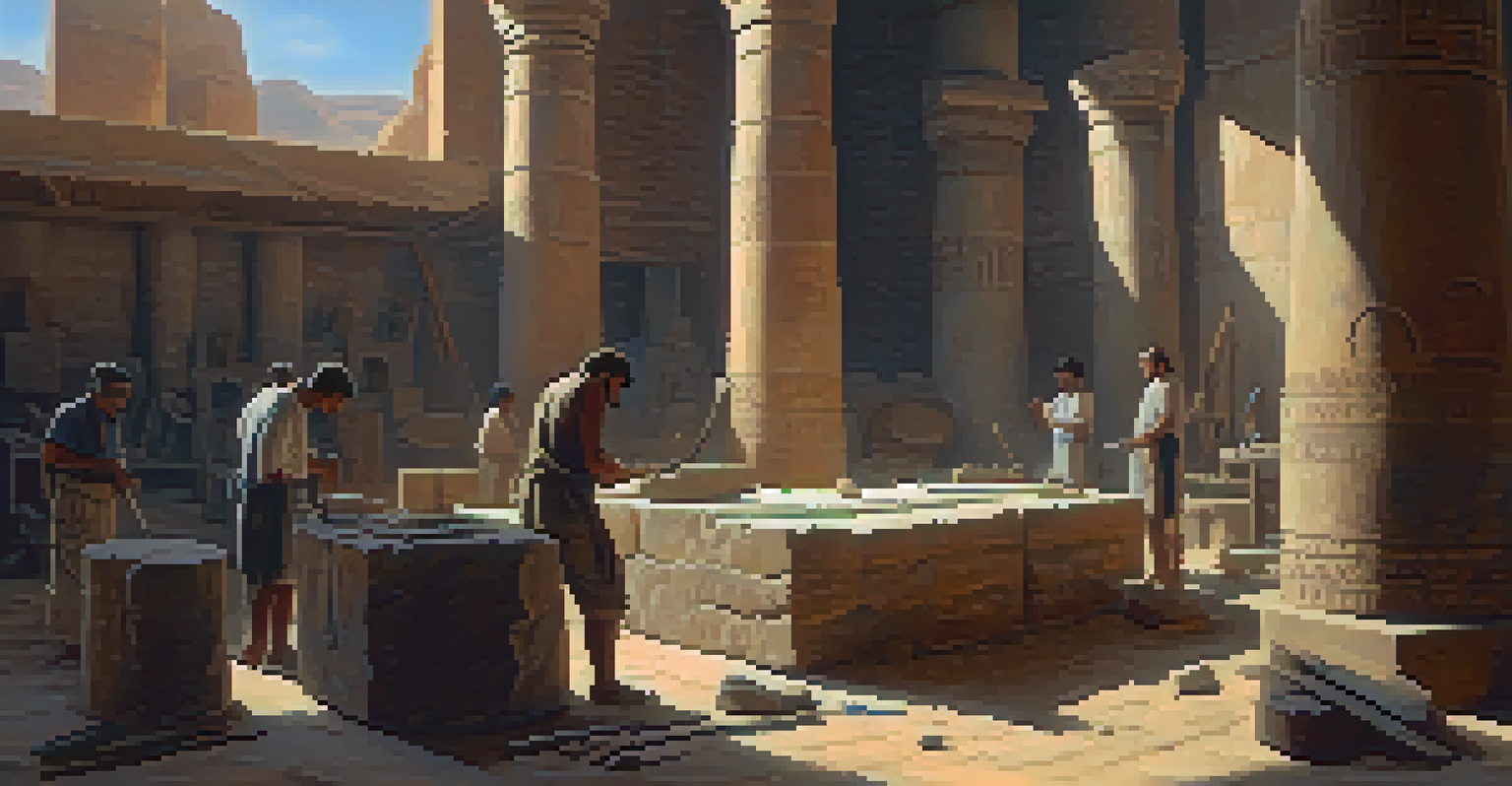Carving in Stone: The Masterpieces of Ancient Egypt

The Art of Stone Carving in Ancient Egypt
Stone carving was a crucial art form in Ancient Egypt, showcasing not only their skills but also their beliefs and values. Craftsmen, known as sculptors, used a variety of tools to create intricate designs. This practice was deeply intertwined with the culture, as many carvings depicted gods, pharaohs, and everyday life, reflecting the society's hierarchy and spirituality.
Art is not what you see, but what you make others see.
The primary materials used were limestone, granite, and sandstone, each selected for its unique qualities. Limestone was favored for its softness, making it easier to carve, while granite was chosen for its durability and grandeur. The choice of stone often conveyed the importance of the subject, with harder stones being reserved for monumental pieces.
Stone carvings were not merely decorative; they served religious and functional purposes. For instance, carvings in tombs were believed to provide the deceased with a safe passage to the afterlife. This blend of artistry and practicality is what makes Ancient Egyptian stone carvings so fascinating and enduring.
The Tools and Techniques of Ancient Egyptian Sculptors
Ancient Egyptian sculptors employed a range of tools, many of which were made from harder stones like dolerite. They used chisels and hammers to shape their materials, creating both detailed reliefs and free-standing sculptures. The techniques varied from simple pecking to more complex methods like drilling, showcasing an impressive understanding of their craft.

One common technique was the use of a grid system, which helped artists maintain proportions and scale in their work. By transferring the grid onto the stone, they could ensure that the figures remained accurate and lifelike. This method reflects the Egyptians' meticulous nature and their dedication to perfection in art.
Artistry Reflects Egyptian Beliefs
Stone carvings in Ancient Egypt were deeply intertwined with the culture, depicting gods, pharaohs, and daily life while serving both religious and functional purposes.
Additionally, many carvings featured hieroglyphics, the writing system of Ancient Egypt, which added another layer of meaning to the artwork. These inscriptions often included prayers or information about the depicted figures, further highlighting the connection between art and spirituality in their culture.
Symbolism in Egyptian Stone Carvings
Symbolism played a pivotal role in Ancient Egyptian stone carvings, with every detail holding significant meaning. Common symbols, like the ankh representing life or the scarab signifying rebirth, were often incorporated into the artwork. This rich symbolism transformed each piece into a narrative, conveying complex ideas about life, death, and the afterlife.
The past is never dead. It's not even past.
The choice of colors also contributed to the symbolism found in these carvings. For example, blue was associated with the heavens, while green represented fertility and rebirth. These color choices were not arbitrary; they were carefully selected to enhance the spiritual significance of the work.
Moreover, the poses and expressions of the figures were laden with meaning. A pharaoh depicted in a powerful stance conveyed authority, while scenes of daily life emphasized the importance of community and harmony. Through these visual elements, the artists communicated the values and beliefs of their civilization.
Famous Stone Carvings of Ancient Egypt
Among the most celebrated stone carvings are the intricate reliefs found in the tombs of pharaohs. The Tomb of Tutankhamun, for example, features stunning depictions of the young king in various poses, illustrating his divine nature. These masterpieces not only highlight the skill of the artists but also provide insight into the life and beliefs of one of Egypt's most famous rulers.
The Great Sphinx of Giza is another iconic stone carving that captivates visitors to this day. This colossal statue, with the body of a lion and the head of a pharaoh, symbolizes strength and wisdom. Its construction showcases the advanced techniques employed by ancient craftsmen and remains a testament to their enduring legacy.
Symbolism in Every Detail
Each stone carving was rich with symbolism, using specific colors, poses, and hieroglyphics to convey complex ideas about life, death, and spirituality.
Additionally, the temple carvings at Karnak and Luxor are remarkable examples of the grandeur of Egyptian stonework. These temples are adorned with elaborate scenes that tell stories of gods and pharaohs, inviting viewers to witness the divine. Each carving serves as a portal into the rich history and cultural significance of Ancient Egypt.
The Role of Religion in Stone Carving
Religion was a driving force behind many stone carvings in Ancient Egypt. The Egyptians believed in a pantheon of gods, and their artwork often depicted these deities in various forms. Temples and tombs were adorned with carvings intended to honor the gods and ensure protection in the afterlife, reflecting the society's deep spiritual connection.
Many carvings served as offerings, with scenes depicting the act of presenting goods to the gods. These representations were believed to secure favor and blessings, emphasizing the importance of ritual in their culture. The artistry involved in these pieces was a way to communicate with the divine, showcasing the sculptors' reverence for their beliefs.
Furthermore, the afterlife was a central theme in Egyptian religion, and stone carvings played a vital role in this aspect. Tomb carvings often included depictions of the deceased in paradise, surrounded by offerings and protection from deities. This focus on the afterlife underscores the Egyptians' belief in immortality and the significance of art in achieving it.
Preservation Challenges for Ancient Stone Carvings
Despite their durability, Ancient Egyptian stone carvings face numerous preservation challenges. Natural erosion, pollution, and human activity have taken a toll on many historical sites. It’s a sobering reminder of the fragility of these treasures, which have stood the test of time for millennia yet remain vulnerable to modern threats.
Efforts to preserve these masterpieces involve a combination of careful restoration and preventive measures. Archaeologists and conservators work tirelessly to protect sites from further damage, using techniques that honor the original craftsmanship. This ongoing work highlights the importance of safeguarding cultural heritage for future generations.
Preservation of Cultural Treasures
Despite their durability, Ancient Egyptian stone carvings face preservation challenges, highlighting the need for ongoing efforts to protect these invaluable cultural artifacts.
Moreover, public awareness and education play a crucial role in preservation. By engaging local communities and visitors, experts can foster a sense of responsibility towards these ancient sites. The more people understand the significance of these carvings, the more likely they are to appreciate and protect them.
The Legacy of Ancient Egyptian Stone Carving
The legacy of Ancient Egyptian stone carving extends far beyond their time, influencing countless cultures throughout history. The techniques and styles developed by Egyptian artisans laid the groundwork for later art movements across the world. Their work continues to inspire artists today, showcasing the timeless nature of their creativity.
Moreover, these carvings serve as a window into the past, providing invaluable insights into Ancient Egyptian life, beliefs, and society. Each piece tells a story, connecting us with a civilization that thrived thousands of years ago. As such, they are not just artifacts; they are a bridge between past and present.

In conclusion, the masterpieces of Ancient Egyptian stone carving are more than beautiful artifacts; they are a testament to human creativity and resilience. They remind us of the importance of art in understanding our history, culture, and shared humanity. Preserving these treasures ensures that future generations can continue to learn from and appreciate the remarkable achievements of our ancestors.